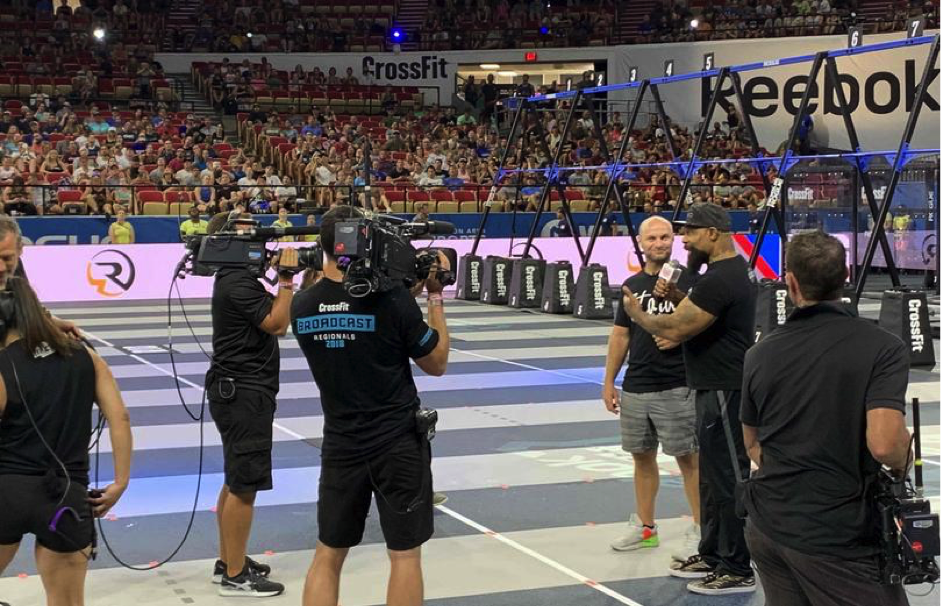How Kiswe’s CloudCast Created 28 Open-Source Broadcasts with the Help of CrossFit’s Community
October 15, 2019
Ever since it became possible to stream video anywhere, many international federations and other sports rights owners have faced a frustrating challenge: creating and delivering relevant content for global audiences who have different wants and needs.
However, the emergence of cloud-based remote production solutions has changed all of that by empowering local voices and commentators to change the narrative of the original live broadcast. Cloud-based technology enables rights holders to scale a single broadcast into many alternate narrowcasts that serve their superfan communities and in turn present new monetization opportunities.
CrossFit is one of the first sports rights owners to seize this new approach of sports broadcasting and use CloudCast to activate its wide-reaching community.
CrossFit is a prominent brand in the fitness industry with more than 15,000 locations worldwide. Launched in 2007, the CrossFit Games is the world’s premier test to find the fittest athletes in the world and has become “one of the fastest-growing sports in America,” according to Forbes. Anyone who’s at least 14 years old can sign up and join in the first stage of the CrossFit Games season. The Games were broadcast live on ESPN from 2011-2016, and on CBS and Facebook from 2017-2018. They were also edited into international episodes with 18 different broadcasters airing the taped shows in their native languages.
Beginning in 2011, CrossFit additionally self-produced the live coverage seen on ESPN+, CBSSports.com, YouTube, Facebook, and other websites. The metrics were enough to rank the CrossFit Games as a top-performing sports partner for Facebook, with remarkable levels of engagement and average view durations. However, two factors were becoming major concerns: the combined high costs for producing televised and digital content, and the Games appearing in English only, despite more than half of their affiliated gyms being located outside the US.
Recognizing this, CrossFit partnered with Kiswe Mobile to formulate an open-source broadcast strategy versus the one-to-many approach employed by the vast majority of sports broadcasters. They worked with Kiswe’s CloudCast platform to produce and distribute their live feed and super-serve the many CrossFit communities and fan bases around the world.
to learn more about CloudCast – please contact: Peter Dunits – Senior Sales Manager – Kiswe Mobile Europe – peter.dunits@kiswe.com
Community-Based Production
This was a very bold decision by CrossFit to produce only a single world feed without any commentary, and invite stakeholders from their passionate community to create and distribute their own broadcasts – and the community responded enthusiastically. The media outlets, sponsors, athletes and fans not only helped distribute the content, but also made it more localized and authentic for the different CrossFit audiences around the world in local languages. Imagine taking an event and transforming it into different narratives tailored to different audiences–all from a single live feed?
Watch Kiswe’s video at iSportconnect TV
Broadcast Quality
CrossFit and Kiswe partnered together to make CloudCast available to their global community and the results have been a game-changer. By using CloudCast, CrossFit was able to create a professional live feed of the CrossFit Games that exceeded broadcast standards and could be leveraged by the many media outlets around the world. CrossFit set no limit on the casters themselves, as long as the content was not placed behind a paywall, and allowed them to choose whatever channel, social network or platform they desired. CloudCast was an extremely cost-effective way to create multiple narratives and easy to use because it required no incremental equipment, no special knowledge, and only very limited training–truly empowering the commentators to provide their own narrative.
There were 28 additional original broadcasts created by the remote teams over the four days of the CrossFit Games: produced locally at far-flung locations in English, Spanish, Portuguese, Russian, Italian, Arabic, Hebrew, French, German and Icelandic.
In the weeks leading up to the event, Kiswe on-boarded 71 remote casters and 29 remote production crews globally to create the content. The casters ranged in expertise from professional broadcast teams and networks, to popular local influencers and even a handful of enthusiastic fans.
Increasing Output
The source content (provided from CrossFit in Madison, Wisconsin) to the CloudCast team totaled 2,040 minutes. The remote teams ended up creating nearly 43,000 of user-facing content minutes from that original stream, from 29 locations all over the world.
Throughout the competition, the operation was supporting the creation of 25-28 original broadcasts per day. Normally, that volume of broadcasts would require a host broadcaster to transport up to 100 people to the event, or send satellite feeds all over the world to control rooms that would need to be paid for and dedicated to create each unique stream.
However, no satellites were used to move content from the American source to each of the 29 destinations. Nor were any new control rooms required, although several outlets supplemented the world feed with studio content and highlight shows before and after the competition. This was true remote production in the cloud: enabling connections with people around the world
Millions Of Daily Views
The viewership figures speak for the quality of the results.
Each day, the CrossFit Games content published on just YouTube and Facebook alone totaled in the range of two million views. Peak concurrent viewership was at least 250,000 viewers and average view durations exceeded 24 minutes,
proving the quality engagement of the community. If there was one downside, it was that with nearly 30 different outlets and end points–many from different countries (including China)–aggregating viewership stats became more challenging, but worthwhile for making the leap from one language to ten in a single year.
The CrossFit community showcased a powerful way that global audiences can authentically connect over live events when given the right tools. We expect to see other sports broadcasters and rights holders explore new opportunities in customizing and personalizing live broadcasts to meet the needs across their different audience segments.



